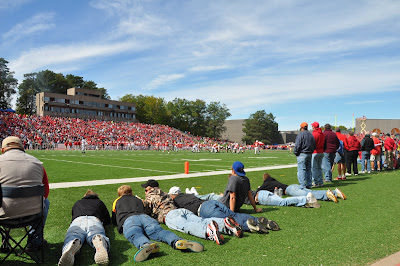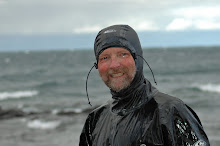 The Apostles were not the only place on the big lake where kayakers were in trouble this month. A week after the tragedy off Sand Island, another search and rescue was performed off Michipicoten Island west of Wawa, ON. A couple in a double capsized in 6' seas near the island. The difference is that they both were successfully rescued when they activated their 406 MHz personal locator beacon.
The Apostles were not the only place on the big lake where kayakers were in trouble this month. A week after the tragedy off Sand Island, another search and rescue was performed off Michipicoten Island west of Wawa, ON. A couple in a double capsized in 6' seas near the island. The difference is that they both were successfully rescued when they activated their 406 MHz personal locator beacon.It sounds like the same air assets that were in the AINL were deployed just a week later in very similar conditions. The Canadian Coast Guard C-130 located the two people and a US Coast Guard helicopter pulled them out of the water. Its great to see such cooperation between the two countries that border Gitchee Gumee, cooperation that's driven by the ancient law of the sea regarding mariners in distress. It would be great if we could work together as closely in the effort to keep crap out of the lake as in the effort to haul people out of the lake. It looks like the PLB was activated around 1pm and both paddlers were on the helicopter at 4pm. Water temp was about 55F.
It sounds like the folks were veteran paddlers, out on a month long trip. Having the PLB was an excellent idea and having it where it could be readily accessed in 6 foot rollers showed even more foresight and planning. An interesting side note was the items that stayed dry after being submerged for 4 days. Our friends at Naturally Superior in Wawa (a place that every Lake Superior afficianado must have on their short list) had the CD Libra double wash up on their beach. The Coast Guard doesn't give a damn about your kayak when they haul you out of the lake so it was lucky the boat showed up in a convenient spot. Every dry bag and double zip locked item was soaking wet. Only 3 containers stayed dry. An Otter box type container from Outdoor Products, a Storus dry pouch, and one of the those cheap plastic Coghlans match containers with the O ring. You can get the full report on Naturally Superiors blog here.
Its great to see that the paddlers got rescued but not so great that they were out in conditions that necessitated them being rescued. Once again that mentality of a good pool player, not just taking the easy shot but setting up to sink 3 or 4 balls, is needed when paddling on Lake Superior. Those folks were lucky. From the accounts it would seem that they were in the water for 3 hours. It doesn't say what they were wearing, but the poor fellow in the AINL perished from hypothermia in under two hours while wearing a 3mm wetsuit. The paddlers off Michipcoten made their luck however, with good preparation. As it says in the article in the Wawa paper, a PLB or EPIRB can take the search out of search and rescue.
 As a side note, we're off to Duluth this weekend to help son 1stLtO get married to MsE from Pipestone, MN. Like many of us, Gitchee Gumee lured them both back from beautiful Queens, NY to get hitched on the shores of Superior. I'm anticipating a flawless weekend, although the car won't know what to do when its rolling down that long hill into Duluth without a couple boats on its roof.
As a side note, we're off to Duluth this weekend to help son 1stLtO get married to MsE from Pipestone, MN. Like many of us, Gitchee Gumee lured them both back from beautiful Queens, NY to get hitched on the shores of Superior. I'm anticipating a flawless weekend, although the car won't know what to do when its rolling down that long hill into Duluth without a couple boats on its roof.






















